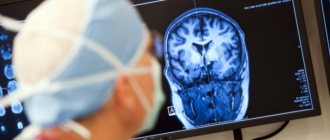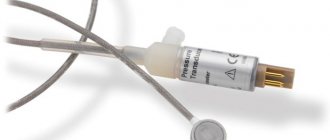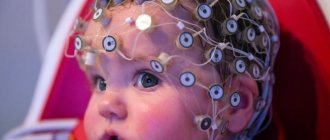Epilepsy is a complex neurological disease characterized by a set of unpleasant symptoms. The problem for sick people is not only long-term treatment with a difficult to predict prognosis, but also the negative attitude of others. One of the common causes of pathology is the inheritance of epilepsy from relatives. Therefore, the risk of a child’s disease seriously worries parents who are carriers of epilepsy.
The answer to the question whether epilepsy is inherited depends on the type of pathology present in the parents. Doctors distinguish three types of epilepsy - idiopathic, symptomatic and cryptogenic. It is known that it is not the pathology itself that is inherited, but the structure of the neurons of the brain, which under certain conditions can cause epilepsy.
Since symptomatic epilepsy occurs due to external causes (diseases, tumors, injuries), this information is absent in the genes. Therefore, parents with symptomatic epilepsy will not pass the disease on to their child.
The idiopathic form of the pathology is genetically determined. It is this case that is considered dangerous for the child, although the transmitted hereditary gene does not necessarily mean the development of the disease. A child can only become a carrier and pass the gene on to his children.
How is epilepsy inherited?
Gene transmission has several nuances that determine how epilepsy is inherited. There are two options:
1. Rolandic epilepsy, which is transmitted by a dominant trait. In this case, the disease manifests itself after a generation and only when the gender matches. The probability of this is far from 100%. There are cases where representatives of several generations of the family were carriers of the gene, and the disease did not occur. The disease can be triggered by a head injury or neuroinfection. In such situations, misdiagnosis and erroneous identification of the symptomatic form of epilepsy are possible.
2. juvenile epilepsy, which is transmitted by a recessive trait. This is a rare form as both parents must be diagnosed with the disease, which is unlikely. In the case of such a coincidence, the disease will manifest itself in the child in the first years of life.
Another form of pathology is cryptogenic epilepsy, which theoretically can also be inherited. Doctors call gene mutation one of the reasons for the cryptogenic form, but whether the altered gene will be preserved in the next generation has not yet been clarified.
Types of hereditary epilepsy
Unlike the acquired form of the disease, the clear cause of the idiopathic disease cannot be identified, since there are no organic brain lesions. However, through genetic research it is possible to determine the hereditary causes of epilepsy. The mechanisms of transmission of the disease from parent to child are ambiguous. There are only 6 types of inheritance: autosomal dominant, autosomal recessive, sex-linked, mitochondrial. The most common types are the autosomal dominant type (for example, Dravet syndrome) and the autosomal recessive type (for example, progressive myoclonus epilepsy).
Is it possible to reduce the risk of inheriting epilepsy?
A geneticist can make a prognosis regarding a child’s predisposition to epilepsy after conducting a series of appropriate tests. The likelihood of the disease depends on the gender of the parent with the diagnosed pathology:
• how often can epilepsy be inherited from the father? The risk of developing a disease in a child is from 1% to 4%
• how often can epilepsy be inherited from the mother? If the mother has pathology, the child becomes ill in 2.5%-9% of cases.
It is impossible to prevent the transfer of the gene, but the disease may not manifest itself. It is within the power of parents to eliminate as much as possible the provoking factors that can cause epilepsy. The child should be protected from falls, injuries, serious infectious diseases, and stress.
It is important to pay attention to characteristic symptoms and consult a doctor immediately. Timely adequate treatment will help delay the progression of epilepsy and reduce the severity of the clinical picture.
Development of pathology
Epilepsy is a disease that affects the brain. For various reasons, a malfunction occurs in the electrical activity of its cells, neurons begin to behave inappropriately, and as a result, a pathological electrical discharge occurs in certain areas of the brain, leading to seizures. The disease is considered quite common: 20 affected per 1000 people.
From medical statistics it is known that every one of 50 children out of 1000 had an epileptic attack against a background of very high body temperature.
If future parents are interested in whether epilepsy is inherited or not, it is better for them to visit a geneticist. He will conduct a conversation and prescribe an examination that will help you more likely to name the correct answer, and most likely it will be positive.
It is important to understand that it is not the disease itself that is genetically transmitted, but the pathological structure of the neurons of the brain, which leads to seizures.
Epilepsy in pregnant women
Previously, doctors did not allow women with epilepsy to give birth to children, but now medicine has gained new knowledge and this issue is resolved by a neurologist, based on the type of pathology. Women with diagnosed epilepsy should report their condition to their gynecologist. When planning a pregnancy, a period of remission is selected and a thorough examination is carried out. In some cases, the doctor may advise against conceiving. This may be associated with severe damage to the body.
When pregnancy occurs, the patient is prescribed drugs for epilepsy with a less pronounced effect on the body of the unborn child. At the same time, vitamins and medications are prescribed to increase the chances of having a healthy baby.
During pregnancy, a woman should avoid stress, illness, and any factors that can provoke an attack of epilepsy and worsen the condition.
Epilepsy: cure or remission
Is it possible to be completely cured of epilepsy?
There are 50 forms of epilepsy. Yes, there are some children's forms with an age-limited ending. This means that it is written in a person’s genetic code that at the age of 15 he will forget about the disease. But there are only 2-3 such forms. All other types of epilepsy, which begin before the age of 10 years, and even more so in the second decade, usually last a lifetime.
The task of the epileptologist and the patient’s family is to ensure that a person with a serious brain disease lives his life as fully as possible. And in 60-70% of cases this can be achieved with the help of medication or surgery.
Under no circumstances should you stop taking medications after achieving long-term improvement in your condition. If the patient stops taking the medications, then it will no longer be possible to return to the remission in which he was healthy for many years. In any case, after treatment is discontinued, 70% of patients can no longer become full-fledged members of society. Golden is right by epileptologists: if the patient is doing well, continue to prescribe the same drugs, the same doses.
Epilepsy is treated in only two ways: therapy and surgery. There are no other methods. Correction of amino acids, oil that is dripped onto patients' heads, realignment of vertebrae - all these methods are useless.
Now for an adult patient with epilepsy in Russia there are all treatment options; drugs are available that are registered in the world for the treatment of this disease.
Surgical treatment of epilepsy is developing very actively in our country. There are federal neurosurgical centers not only in Moscow, but also in St. Petersburg and in the regions. The centers are equipped with the latest technology, and the doctors who work there are well trained.
The country allocates quotas for many neurosurgical interventions, so high-tech medical care is available even to low-income people with epilepsy.
How is epilepsy diagnosed?
Unfortunately, our doctors were taught for many years that the diagnosis of “epilepsy” can only be made if you see epiactivity of the brain on an electroencephalogram. This is wrong. The diagnosis is made by clinical signs. But sometimes it reaches the point of absurdity. A patient may suffer from epileptic seizures for years, have convulsions, emit foam, and may fall into a seizure even in the doctor’s office, but if there is no epileptic activity on the EEG, then there is no epilepsy.
The patient and his relatives must take an active position: if one doctor did not help, they must get a second opinion. The patient has the right to this. The same applies to treatment. World statistics show that from the moment therapy begins, seizures are completely and reliably controlled in 47% of cases, that is, in almost half of the situations. If this does not happen, consult another doctor.
The non-profit organization “Association of Epileptologists and Patients,” where I work, has 15 representative offices throughout the country from St. Petersburg to Vladivostok. We can tell the patient where a good doctor is seen in his region, where he can go for diagnosis and treatment. Our organization's address is [email protected]
First aid
It is necessary to remove sharp, heavy objects and those that are dangerous for the patient and others.
It is advisable to find something soft to place under the patient’s head. Do not hold the patient by force - this will worsen the condition. You need to note for yourself the time the attack began; if it lasts more than 5 minutes, you need to call a medical ambulance. There is no need to unclench your jaws so as not to injure your tongue, teeth and oral mucosa due to muscle hypertonicity. It is necessary to fix the victim’s head between the legs, place clothes, a blanket, a pillow under it, or roll up the clothes. Tight clothing needs to be loosened. If there is excessive salivation or vomiting, then the head or the entire body must be turned to one side. The patient may experience spontaneous urination.
You should seek medical help if:
- traumatization;
- if the attack lasts more than 5 minutes or repeats without the person returning to consciousness;
- if the seizure happened for the first time;
- if an attack occurs in a pregnant woman, a child, or an elderly person.
After the attack ends, it is necessary to place the victim in a comfortable position, perhaps on his side. Check if the airways are clear. When a person begins to come to his senses and can already coordinate movements, it is advisable to help him and try to calm him down.
Usually, patients with epilepsy have a note with them with their contacts, phone numbers of relatives, and home address. Relatives need to be notified about what happened.
Symptoms:
- convulsive movements;
- mental disorders;
- disorders of sound, taste, smell.
Complex partial seizures
Characteristic symptoms are a simple attack, but with impaired consciousness. “Automatic” behavior is noted: fiddling with clothes, buttons, wandering without purpose, a grimace may be distorted on the face, the jaw may perform chewing movements. They can become secondary generalized.
Secondary generalized seizures
Complex seizures with the spread of the epileptic discharge to both hemispheres of the brain. Sudden loss of consciousness, before this there may be a sensation of an aura, but not always. There may be convulsive muscle movements. In this case, the period of loss of consciousness can be very short and unnoticeable even for the patient himself.
Partial or focal seizures
These are the most common manifestations of epilepsy.
They occur when cells are damaged in a certain area of one or the other hemisphere of the brain. Symptoms allow you to determine the source of damage. They are divided into simple, complex and secondary generalized. Simple partial seizures It may be a precursor to a complex partial seizure. Consciousness is not impaired. Patients report the condition as an aura. It is characterized by a state of euphoria, a feeling of unpleasant odors, unusual sounds, darkening of the eyes, anxiety, a feeling of fear, restlessness. Having learned to identify the aura, the patient is able to prevent and prevent complications.
Electrical stimulation of the vagus nerve
This type of treatment is prescribed as an additional method of therapy.
In many countries it is an adjuvant treatment method. It reduces the number of partial seizures in children and adults. Therapy helps prevent the abnormal activity that leads to seizures.
An electrical pulse generator is used and inserted under the collarbone or under the skin near the armpit. The electrode is attached to the vagus nerve. This method allows to reduce the frequency of seizures in patients.
Localization of the lesion
Symptoms can inform the doctor about the location of the lesion.
Temporal lobe epilepsy most often manifests itself as a feeling of déjà vu. The cells of this part of the brain are responsible for memory, sound perception, and emotions. The patient may think that he hears music. Damage to this part of the brain is characterized by the experience of emotions - anxiety, fear, worry, joy, admiration.
Frontal lobe epilepsy has many different symptoms, depending on the part of the frontal lobe that is involved. The patient may experience many emotions, perform repetitive movements, chewing, and tongue movements.
Parietal epilepsy is rare. The parietal lobe of the brain is responsible for the sensitivity of the body. A person may feel warmth in the body, tingling, and a feeling that the body is being divided into parts. The brain distorts perception and a person misinterprets what is happening to him.
Occipital epilepsy is rare. With this type, visual hallucinations and loss of part of the field of vision occur. The eyes may move, and the person may experience severe headaches.
Myth. Women with epilepsy should not become pregnant or give birth
In fact . The only danger is in cases where epileptic seizures cannot be controlled. The fact is that a seizure can provoke oxygen starvation of the fetus and lead to serious consequences for the baby’s health. If you can achieve stable remission (no attacks for a year), you can plan a pregnancy.
Interesting
In the Middle Ages, epilepsy was considered contagious and patients were placed in separate asylums. In Nazi Germany, all patients with epilepsy were subject to forced sterilization. In Britain, people with epilepsy were not allowed to marry. This ban was in effect until 1970. In India and China, such a ban is still in effect.
If someone has an epileptic attack before your eyes:
- Lay the person down on the ground or on a bed.
- Turn the patient on his side to prevent him from choking on saliva.
- Hold the patient gently so that he does not hit his head on any object.
- Under no circumstances should you try to unclench the patient’s jaws or try to insert a hard object into the mouth, because you can break the teeth.
- Do not try to give water to a person.
- Record the time when the attack began and tell the arriving doctor.
- During an attack, there is no need to restrain a person’s natural movements. The main task is not to harm the patient and try to alleviate his condition.
What diseases should epilepsy be distinguished from?
In the newborn period, motor restlessness and tremor (shaking) may resemble symptoms of seizures.
In children, it is necessary to distinguish from epileptic seizures: pseudoepileptic (“hysterical”) seizures, fainting, migraines, tics (and other hyperkinesis), non-epileptic myoclonus, night terrors, somnambulism (sleepwalking), some diseases of the gastrointestinal tract (gastro-esophageal reflux) , benign paroxysmal dizziness, metabolic disorders (hypocalcemia).
Under the “mask” of epilepsy in adulthood, pseudoepileptic seizures, fainting, migraines, transient ischemic attacks, attacks of obstructive sleep apnea, narcolepsy, catalepsy, panic attacks, and hypoglycemia can occur.
The differential diagnosis of epilepsy in the elderly includes cardiac arrhythmias, transient ischemic attacks, metabolic disorders and sleep apnea.
Diagnostics
In the diagnosis of epilepsy, patient interviews, electroencephalographic studies, and magnetic resonance imaging of the brain are of greatest importance. When collecting the patient's medical history, the year and age of the patient during the first attack, the regularity of occurrence, the patient's sensations before the onset and immediately after the end of the attack, and the nature of muscle spasms are specified.
It is possible to obtain answers to the above questions from the patient’s relatives who are witnesses to the attacks. Provided an accurate description of the disease, a neurologist can determine in which area of the brain the focus of epiactivity is located. It is necessary to carry out differential diagnosis with hysterical seizures, syncope, neurogenic seizures of non-epileptic nature (tics), neurological diseases (transient cerebrovascular accident, migraine).
A mandatory research method is EEG to identify epileptic patterns (although during the initial EEG registration, episigns are detected in only 40% of patients, with repeated recordings - up to 80%, the use of provocative tests helps to identify pathology on the EEG in 95-97% of patients). MRI and CT are indicated for all patients with partial onset/type of epileptic seizure, as well as when the first seizure occurs after 30 years without apparent cause. An examination by an ophthalmologist (fundus of the eye), biochemical blood tests, cardiac examination and Doppler ultrasound are required (especially in older and elderly people).
Clinical picture
The course of hereditary epilepsy is no different from the course of acquired pathology. It is characterized by:
- fainting;
- convulsions;
- foaming at the mouth during an attack;
- short-term loss of consciousness.
In some cases, a patient who has already had a series of attacks can anticipate the onset of a new one several days in advance. This happens:
- disturbance of night sleep;
- headache and excessive irritability appear;
- decreased appetite;
- the appearance of a stereotypical aura and other symptoms by which the patient understands the approach of the inevitable.
After the appearance of the aura (lasting several seconds), loss of consciousness is possible with the patient falling to the floor, which is very often accompanied by a scream. Breathing movements slow down, the veins in the neck swell. The facial coverings turn pale, the jaws clench tightly. Tonic convulsions appear, and this state continues for approximately 20 seconds. The duration of this phase is about three minutes.
For Rolandic epilepsy, the characteristic time of occurrence is mainly at night (80% - the first half of the night, 20% - while awake). The convulsive state is more short-term in nature.
The first appearance of attacks for the myoclonic form is typical at the age of 10-19 years. Mental disorders act as precursors. Seizures are observed either daily, or at intervals of several months, or even less frequently.
The correct diagnosis is established by a qualified specialist. Only about 8% of sick people have a history of this pathology in their relatives.
Effective therapy
Drug therapy
The doctor prescribes anticonvulsants; they suppress the occurrence of pathological impulses in the brain. Additionally, anticonvulsants and psychotropic drugs (hypnotics, antidepressants, tranquilizers) are prescribed. Psychotropic medications should be taken without violating the doses prescribed by the doctor. Because they may be triggers for attacks or side effects.
The disease can be controlled with drug therapy, and sometimes complete cure of the disease can be achieved.








